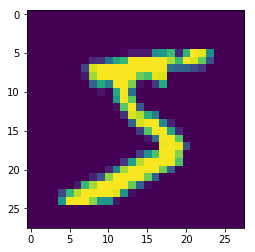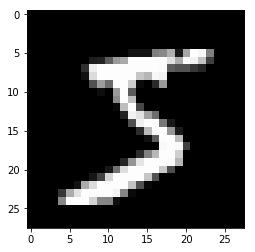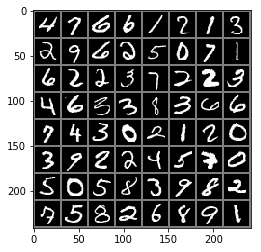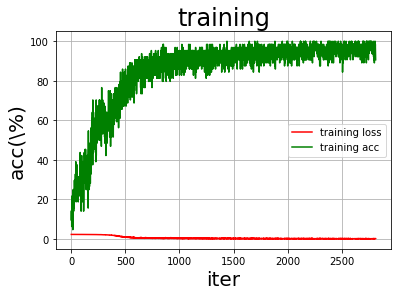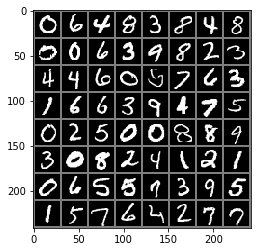使用Pytorch框架的CNN网络实现手写数字(MNIST)识别 本实践使用卷积神经网络(CNN)模型,用于预测手写数字图片。代码源文件在github 上面
首先导入必要的包
numpy—————>python第三方库,用于进行科学计算
PIL——————> Python Image Library,python第三方图像处理库
matplotlib——->python的绘图库 pyplot:matplotlib的绘图框架
os——————->提供了丰富的方法来处理文件和目录
1 2 3 4 5 6 7 8 import numpy as npimport torch from torch import nnfrom PIL import Imageimport matplotlib.pyplot as pltimport osfrom torchvision import datasets, transforms,utils
Step1:准备数据。 (1)数据集介绍
MNIST数据集包含60000个训练集和10000测试数据集。分为图片和标签,图片是28*28的像素矩阵,标签为0~9共10个数字。
(2)data_train和data_test
(3)打印看下数据是什么样的?数据已经经过transform的归一化处理
class torchvision.transforms.Normalize(mean, std):
1 2 transform = transforms.Compose([transforms.ToTensor(), transforms.Normalize(mean=[0.5 ],std=[0.5 ])])
1 2 3 4 5 6 7 8 train_data = datasets.MNIST(root = "./data/" , transform=transform, train = True , download = True ) test_data = datasets.MNIST(root="./data/" , transform = transform, train = False )
数据下载慢的问题:https://blog.csdn.net/qq_31904559/article/details/96591484?depth_1-utm_source=distribute.pc_relevant.none-task&utm_source=distribute.pc_relevant.none-task
train_data 的个数:60000个训练样本
test_data 的个数:10000个训练样本
一个样本的格式为[data,label],第一个存放数据,第二个存放标签
https://pytorch-cn.readthedocs.io/zh/latest/package_references/data/
1 2 3 4 train_loader = torch.utils.data.DataLoader(train_data,batch_size=64 , shuffle=True ,num_workers=2 ) test_loader = torch.utils.data.DataLoader(test_data,batch_size=64 , shuffle=True ,num_workers=2 )
设置batch_size=64后,加载器中的基本单为是一个batch的数据
所以train_loader 的长度是60000/64 = 938 个batch
test_loader 的长度是10000/64= 157个batch
1 2 print(len (train_loader)) print(len (test_loader))
加载到dataloader中后,一个dataloader是一个batch的数据
从二维数组生成一张图片
1 2 3 4 5 6 7 8 oneimg,label = train_data[0 ] oneimg = oneimg.numpy().transpose(1 ,2 ,0 ) std = [0.5 ] mean = [0.5 ] oneimg = oneimg * std + mean oneimg.resize(28 ,28 ) plt.imshow(oneimg) plt.show()
从三维生成一张黑白图片
1 2 3 4 5 6 7 8 oneimg,label = train_data[0 ] grid = utils.make_grid(oneimg) grid = grid.numpy().transpose(1 ,2 ,0 ) std = [0.5 ] mean = [0.5 ] grid = grid * std + mean plt.imshow(grid) plt.show()
输出一个batch的图片和标签
1 2 3 4 5 6 7 8 9 10 11 12 13 14 15 images, lables = next (iter (train_loader)) img = utils.make_grid(images) img = img.numpy().transpose(1 ,2 ,0 ) std = [0.5 ] mean = [0.5 ] img = img * std + mean for i in range (64 ): print(lables[i], end=" " ) i += 1 if i%8 is 0 : print(end='\n' ) plt.imshow(img) plt.show()
1 2 3 4 5 6 7 8 tensor(4) tensor(7) tensor(6) tensor(6) tensor(1) tensor(2) tensor(1) tensor(3) tensor(2) tensor(9) tensor(6) tensor(2) tensor(5) tensor(0) tensor(7) tensor(1) tensor(6) tensor(2) tensor(2) tensor(3) tensor(7) tensor(2) tensor(2) tensor(3) tensor(4) tensor(6) tensor(3) tensor(3) tensor(8) tensor(3) tensor(6) tensor(6) tensor(7) tensor(4) tensor(3) tensor(0) tensor(2) tensor(1) tensor(2) tensor(0) tensor(3) tensor(9) tensor(2) tensor(2) tensor(4) tensor(5) tensor(7) tensor(0) tensor(5) tensor(0) tensor(5) tensor(8) tensor(3) tensor(9) tensor(8) tensor(2) tensor(7) tensor(5) tensor(8) tensor(2) tensor(6) tensor(8) tensor(9) tensor(1)
Step2.网络配置 网络结构是两个卷积层,3个全连接层。
Conv2d参数
in_channels(int) – 输入信号的通道数目
out_channels(int) – 卷积产生的通道数目
kerner_size(int or tuple) - 卷积核的尺寸
stride(int or tuple, optional) - 卷积步长
padding(int or tuple, optional) - 输入的每一条边补充0的层数
1.定义一个CNN网络
1 2 3 4 5 6 7 8 9 10 11 12 13 14 15 16 17 18 19 20 21 22 23 24 25 import torch.nn.functional as Fclass CNN (nn.Module ): def __init__ (self ): super (CNN,self).__init__() self.conv1 = nn.Conv2d(1 ,32 ,kernel_size=3 ,stride=1 ,padding=1 ) self.pool = nn.MaxPool2d(2 ,2 ) self.conv2 = nn.Conv2d(32 ,64 ,kernel_size=3 ,stride=1 ,padding=1 ) self.fc1 = nn.Linear(64 *7 *7 ,1024 ) self.fc2 = nn.Linear(1024 ,512 ) self.fc3 = nn.Linear(512 ,10 ) def forward (self,x ): x = self.pool(F.relu(self.conv1(x))) x = self.pool(F.relu(self.conv2(x))) x = x.view(-1 , 64 * 7 * 7 ) x = F.relu(self.fc1(x)) x = F.relu(self.fc2(x)) x = self.fc3(x) return x net = CNN()
2.定义损失函数和优化函数
1 2 3 4 5 6 import torch.optim as optimcriterion = nn.CrossEntropyLoss() optimizer = optim.SGD(net.parameters(), lr=0.001 , momentum=0.9 )
Step3.模型训练 1 2 3 4 5 6 7 8 9 10 11 12 13 14 15 16 17 18 19 20 21 22 23 24 25 26 27 28 29 30 31 32 33 34 35 36 37 train_accs = [] train_loss = [] test_accs = [] device = torch.device("cuda:0" if torch.cuda.is_available() else "cpu" ) net = net.to(device) for epoch in range (3 ): running_loss = 0.0 for i,data in enumerate (train_loader,0 ): inputs,labels = data[0 ].to(device), data[1 ].to(device) optimizer.zero_grad() outputs = net(inputs) loss = criterion(outputs,labels) loss.backward() optimizer.step() running_loss += loss.item() if i%100 == 99 : print('[%d,%5d] loss :%.3f' % (epoch+1 ,i+1 ,running_loss/100 )) running_loss = 0.0 train_loss.append(loss.item()) correct = 0 total = 0 _, predicted = torch.max (outputs.data, 1 ) total = labels.size(0 ) correct = (predicted == labels).sum ().item() train_accs.append(100 *correct/total) print('Finished Training' )
1 2 3 4 5 6 7 8 9 10 11 12 13 14 15 16 17 18 19 20 21 22 23 24 25 26 27 28 [1, 100] loss :2.292 [1, 200] loss :2.261 [1, 300] loss :2.195 [1, 400] loss :1.984 [1, 500] loss :1.337 [1, 600] loss :0.765 [1, 700] loss :0.520 [1, 800] loss :0.427 [1, 900] loss :0.385 [2, 100] loss :0.339 [2, 200] loss :0.301 [2, 300] loss :0.290 [2, 400] loss :0.260 [2, 500] loss :0.250 [2, 600] loss :0.245 [2, 700] loss :0.226 [2, 800] loss :0.218 [2, 900] loss :0.206 [3, 100] loss :0.183 [3, 200] loss :0.176 [3, 300] loss :0.174 [3, 400] loss :0.156 [3, 500] loss :0.160 [3, 600] loss :0.147 [3, 700] loss :0.146 [3, 800] loss :0.130 [3, 900] loss :0.115 Finished Training
模型的保存
1 2 PATH = './mnist_net.pth' torch.save(net.state_dict(), PATH)
Step4.模型评估 画图
1 2 3 4 5 6 7 8 9 def draw_train_process (title,iters,costs,accs,label_cost,lable_acc ): plt.title(title, fontsize=24 ) plt.xlabel("iter" , fontsize=20 ) plt.ylabel("acc(\%)" , fontsize=20 ) plt.plot(iters, costs,color='red' ,label=label_cost) plt.plot(iters, accs,color='green' ,label=lable_acc) plt.legend() plt.grid() plt.show()
1 2 train_iters = range (len (train_accs)) draw_train_process('training' ,train_iters,train_loss,train_accs,'training loss' ,'training acc' )
检验一个batch的分类情况
1 2 3 4 5 6 7 8 9 10 11 12 dataiter = iter (test_loader) images, labels = dataiter.next () test_img = utils.make_grid(images) test_img = test_img.numpy().transpose(1 ,2 ,0 ) std = [0.5 ,0.5 ,0.5 ] mean = [0.5 ,0.5 ,0.5 ] test_img = test_img*std+0.5 plt.imshow(test_img) plt.show() print('GroundTruth: ' , ' ' .join('%d' % labels[j] for j in range (64 )))
1 GroundTruth: 0 6 4 8 3 8 4 8 0 0 6 3 9 8 2 3 4 4 6 0 5 7 6 3 1 6 6 3 9 4 7 5 0 2 5 0 0 8 8 9 3 0 8 2 4 1 2 1 0 6 5 5 7 3 9 5 1 5 7 6 4 2 7 7
1 2 3 test_net = CNN() test_net.load_state_dict(torch.load(PATH)) test_out = test_net(images)
输出的是每一类的对应概率,所以需要选择max来确定最终输出的类别
1 2 3 4 _, predicted = torch.max (test_out, dim=1 ) print('Predicted: ' , ' ' .join('%d' % predicted[j] for j in range (64 )))
1 Predicted: 0 6 4 8 3 8 4 8 0 0 6 3 9 8 2 3 4 4 6 0 6 7 6 3 1 6 6 3 9 6 7 5 0 2 5 0 0 2 8 9 3 0 8 2 4 1 2 1 0 6 5 5 9 3 9 5 1 5 7 6 4 2 7 7
测试集上面整体的准确率
1 2 3 4 5 6 7 8 9 10 11 12 correct = 0 total = 0 with torch.no_grad(): for data in test_loader: images, labels = data outputs = test_net(images) _, predicted = torch.max (outputs.data, 1 ) total += labels.size(0 ) correct += (predicted == labels).sum ().item() print('Accuracy of the network on the test images: %d %%' % ( 100 * correct / total))
1 Accuracy of the network on the test images: 96 %
10个类别的准确率
1 2 3 4 5 6 7 8 9 10 11 12 13 14 15 16 17 18 class_correct = list (0. for i in range (10 )) class_total = list (0. for i in range (10 )) with torch.no_grad(): for data in test_loader: images, labels = data outputs = test_net(images) _, predicted = torch.max (outputs, 1 ) c = (predicted == labels) for i in range (10 ): label = labels[i] class_correct[label] += c[i].item() class_total[label] += 1 for i in range (10 ): print('Accuracy of %d : %2d %%' % ( i, 100 * class_correct[i] / class_total[i]))
1 2 3 4 5 6 7 8 9 10 Accuracy of 0 : 99 % Accuracy of 1 : 98 % Accuracy of 2 : 96 % Accuracy of 3 : 91 % Accuracy of 4 : 97 % Accuracy of 5 : 95 % Accuracy of 6 : 96 % Accuracy of 7 : 93 % Accuracy of 8 : 94 % Accuracy of 9 : 92 %
参考 https://blog.csdn.net/weixin_45885232/article/details/103950992
https://zhuanlan.zhihu.com/p/30249139
https://pytorch.org/tutorials/beginner/blitz/cifar10_tutorial.html#sphx-glr-beginner-blitz-cifar10-tutorial-py
